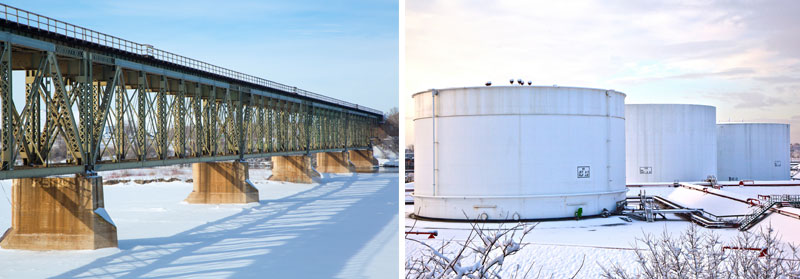Across much of the United States warm temperatures are already a distant memory. Weekly Toolbox Talks and daily safety meetings have long moved on from discussing the dangers of heatstroke, dehydration and severe sunburn.
Now toolbox topics are focusing on the perils of winter work outdoors (or perhaps have for some time now in the country’s northern reaches). Here are some toolbox topics project managers and foremen should consider discussing with crews as the mercury continues to drop.

Staying warm: It’s all about the base layer
Well, maybe that’s a stretch. There’s a lot to be said for a big, thick parka when temperatures remain low. A good pair of gloves made of a warm material that still allows for the dexterity needed to deal with nuts and bolts is essential. The power of some insulated coveralls to keep out the cold can’t be underestimated. And a good pair of thick wool socks.
But perhaps just as important is a heavy layer close to the skin. Many Thomas crewmembers prefer Under Armour’s cold weather gear. These layers, often polyester, have the added advantage of wicking away the moisture guaranteed to frustrate any attempt to stay warm.
When it comes right down to it, dressing properly for winter weather is a head-to-toe job, but it’s important to remember it starts at skin level. Layering is key.
Wind and rain
Painters know that rain will quickly put the breaks on tasks like abrasive blasting, because wet grit can’t be recollected and reused. But wind is another consideration that should be evaluated daily to keep crews safe. Lifts, for instance, are rated only to withstand winds up to certain speeds.
Equipment limitations should be an important factor in daily safety talks, but weather does not have to have the final say in the productivity of a job-site. Often when wind and rain make one portion of the job unsafe, focus can be shifted to another aspect of the job.
On the Hoan Bridge in Milwaukee for instance, high winds blowing in off lake Michigan frequently make work high on the bridge unsafe. In order to ensure progress is made on the job, Thomas Industrial Coatings crews install sections of SafeSpan beneath the bridge during especially blustery periods. High winds and extreme cold may prevent some of the work on the Hoan Bridge for much of the winter, but by proceeding with the installation of the temporary work platform, crews will be ready to resume when Spring comes.
Snow is heavy
So is ice. They can become significant safety hazards, both on active job-sites and in the yard. Any water left to freeze on or inside materials will substantially increase the item’s weight, and it’s important to make sure lifting equipment, whether that means a forklift or your own back, is equal to the task.
The weight of accumulated snow can also pose a danger to staging systems. Temporary work platforms need to be cleared of build-ups of snow before the accumulation reaches dangerous levels.
Many factors can complicate calculating when the weight of snowfall will supersede the rating of a temporary work platform, such as water content and melting and refreezing. OSHA provides some good resources for the safe removal of accumulated snowfall from elevated surfaces.
A daily concern
At Thomas Industrial Coatings, Mother Nature plays a big role in how we execute our jobs. Painting requires a certain set of conditions which vary for every product. Not only in severe weather events like snowstorms and high winds, but ambient conditions such as temperature and humidity also have an effect on a coating’s performance.
With more than 20 years experience in painting and coating all sorts of structures in all sorts of weather, these are the things we are constantly considering. For more on what you should consider when hiring an industrial coatings specialist, download our Buyer’s Guide below.


